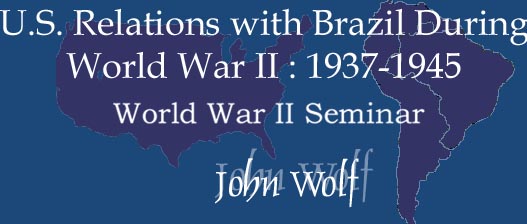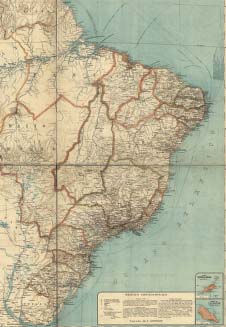| Contents:
Early Relations and the Question of Fascism 1939 -- The Breakthrough Year: Putting Suspicion to Bed Materials and the Development of Brazilian Industry |

Air Support
|
|
The first step in the process on the side of the United States was to commission an airline to build a field at Natal in Rio Grande do Norte. Pan-American Airlines was chosen to build the air field, for it was already an instrument of Roosevelt's Good Neighbor Policy and had already established some minimal flights to Natal (map from Life magazine 1936). However, before the war only three airlines connected Europe with Latin America: Air France, Lufthansa, and LATI (Linea Aeree Transcontinentali Italiane), and all were government-controlled. Luckily, Air France controlled the primitive air fields already established at Natal. Because LATI was an Italian company, and Italy was under the control of Mussolini, Axis influence had to be removed from Latin America. This was not easy in light of Vargas' continuing relations with Germany. Pan-Am, furthermore, was not capable of assuming all other airline routes, and other companies remained open. However, as the war progressed in 1940, Vargas and Roosevelt were able to force competition out of Brazil economically, and Pan-Am obtained sole flying rights to complete the triangle from the United States to Brazil, and then on to North Africa and Europe.
 |
In order to construct the necessary air bases in Brazil, President Roosevelt subsidized Pan-Am through the Military Appropriation Act of 1940. As part of the New Deal and the war effort, Roosevelt created the Airport Development Program (ADP) in 1940, which was responsible for the management of building in Natal, as well as the intricacies of opening an airport in another country. These specifics included the employment of local labor, land appropriation, and installation and operation of radio equipment. Operating rights were sought for twenty-year periods. Interestingly, the airfield in Natal, upon completion, was to be turned over to the Brazilian government for operation and management, for a total, over twenty years, of $1,350,000. Work in Natal was of utmost importance for the United States government, for Rommel's forces were sweeping through North Africa, and the Brazilian air base was the sole supply force for British resistance. Natal was meant to trampoline supplies from America to North Africa. It was not until September 1940 that construction supplies for the base were imported, including "graders, bulldozers, [and] heavy trucks." American operators went with the building materials, but never any American ground troops. Vargas was insistent upon having Brazil's own forces protect the newly erected base. The Brazilian air base became a showcase for the global air support provided by companies like Pan-Am. (Time magazine ads Oct. 1944 and Nov. 1944)
